Introduction
Leptoglossus zonatus (Dallas) is widely known as the western leaffooted bug, but this is not an approved common name. Leptoglossus zonatus is a prevalent polyphagous minor pest of various field, vegetable and fruit crops in the Gulf Coast region of the United States. It has become a key pest in citrus, especially of satsuma mandarin (Citrus unshiu Mar.). It is also considered an important emerging pest on a wide range of crops including corn, cotton, eggplant, peach, pecan, pomegranate, tomato, and watermelon in the United States (Xiao and Fadamiro 2011).
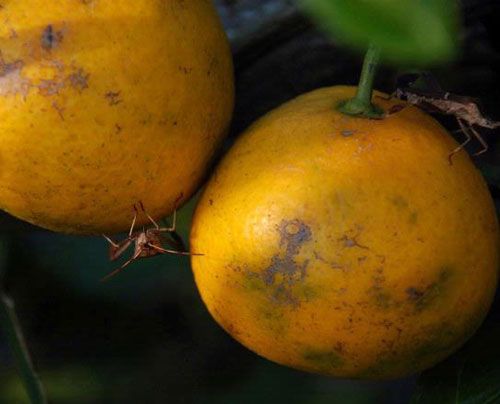
Credit: Ayanava Majumdar, Alabama Cooperative Extension System; www.ipmimages.org
Distribution
Leptoglossus zonatus occurs in the southern and western United States, including Arizona, California, Florida, Louisiana, and Texas (Buss et al. 2011). In addition, its range extends south through Mexico and Central America into the northern half of South America (Allen 1969, Henne and Johnson 2003, Buss et al. 2011). Western leaffooted bug became the dominant leaf-footed bug species in Satsuma oranges by 2001 after its first appearance in Louisiana in 1996.
Description
Adults
The adult western leaffooted bugs are 19–21 mm long, dark brown, with flattened leaf-like expansions on the hind tibia. The adult is distinguished from the other Leptoglossus spp. by having a whitish zigzag band across the corium and two pale yellow spots on the anterior pronotum.
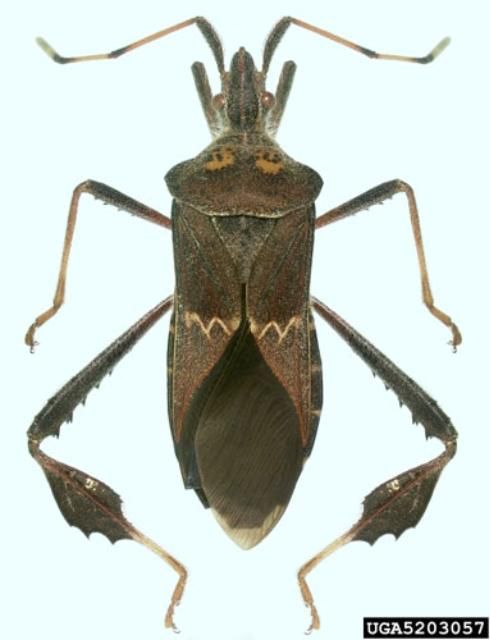
Credit: Natasha Wright, Florida Department of Agriculture and Consumer Services; www.ipmimages.org
Eggs
The eggs are laid in chains of up to 50 or more on branches, leaves or peduncles of host plants. Most eggs of the family Coreidae (leaf-footed bugs) are golden brown and usually laid in single rows along stems or leaf midribs. Eggs also exhibit flattened round structures clearly visible at the ends which the nymphs use to exit the egg.
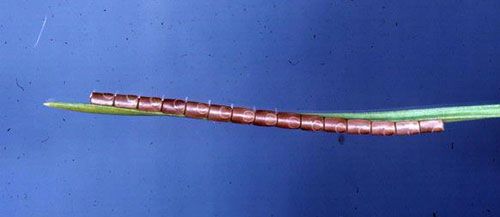
Credit: Lacy Hyche, Auburn University; www.ipmimages.org
Nymphs
There are five wingless nymphal instars. Nymphs mostly have black legs, while their bodies range in color from orange to reddish brown. The leaf-like hind tibia, a common defining characteristic of the family Coreidae, does not develop in the early instars. It develops during the latter instars along with the change to adult coloration.
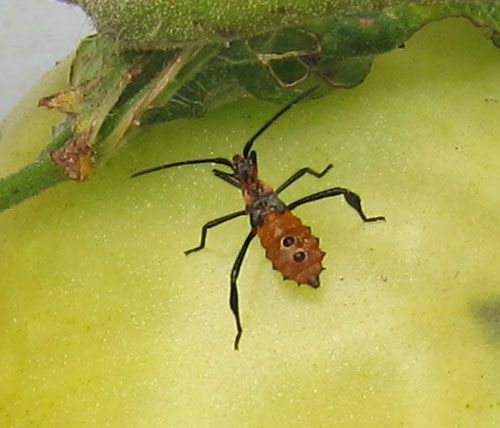
Credit: Henry Fadamiro, Auburn University
Life Cycle and Biology
Leptoglossus zonatus overwinters as an adult in areas that commonly have weeds (e.g., fence rows, abandoned crops), and under tree bark. However, they can usually be found at variable population densities in the field throughout the year. In addition, L. zonatus female longevity is significantly greater than male longevity of 73 days and 53 days, respectively. The developmental period from egg to the fifth instar is approximately 50 days under the following conditions; 25 ± 2°C, 50 ± 10% RH, and a photoperiod of 14 hours. Interestingly, the cumulative survivorship from eggs through the fifth nymphal stage is near 76%. Leptoglossus zonatus can reach a hatch rate of up to 98%, making it a very prolific pest (Xiao and Fadamiro 2009).
Adults and nymphs possess different alarm pheromone systems, which are not life-stage specific (Panizzi et al. 1994). These chemicals are likely involved in L. zonatus territorial defense or recognition behavior as well as being key factors in host-plant selection by L. zonatus. As a result, this behavior may eventually be exploited for population management.
Hosts
The preferred host of L. zonatus is tomato, Solanum lycopersicum, with satsuma a distant second. It is widely reported in Nicaragua that the bugs are one of the two important pests of physic nuts, Jatropha curcas, on which they can complete the entire life cycle. However, in Honduras it is only considered a minor garden pest.
Adult leaffooted bug feeding causes premature color break and fruit drop, which affects market quality. In the fall, L. zonatus normally moves from crop fields (in many instances tomato, cotton, watermelon, etc.) into a neighboring satsuma orchard when ripening begins. Little research has been done, and it remains unclear whether L. zonatus completes its life cycle on satsuma mandarin (Xiao 2009).
Plant Damage
Leptoglossus zonatus feeds on the satsuma mandarin by inserting its piercing-sucking mouthparts in the fruit and releasing a toxic substance; it is also known to transmit the yeast Nematospora coryli. As a result, depending on the density, it causes fruit staining, premature fruit abortion, fruit weight loss, and reduces soluble solids content. Some of the common damage symptoms include the presence of green and dark spots on the outer rind, and the collapsing and drying out of the juice vesicles in the inner rind. In some instances, drying of the internal juice sacs remains hidden but consequently renders the fruit unpalatable. Therefore, due to its potential damage, an economic injury level of 1–2 L. zonatus per fruit is suggested. Additionally, the degree of damage caused by the male and the female does not vary significantly, unlike the damage caused by adults (greater) and nymphs (Xiao and Fadamiro 2009).
A study conducted in Brazil found that L. zonatus can transmit a protozoan plant pathogen known as a trypanosomatid. These organisms are very similar to the trypanosomes that cause Chagas' disease and sleeping sickness, but they are pathogenic to plants and are not known to cause any human illness (Sbravate et al. 1989, Buss et al., 2011). As a result, L. zonatus is categorized as a potential vector of diseases in corn (Brambila 2007). It is estimated that if the bug in maize isn't properly managed crop losses can exceed 15% (Marchiori 2002). Other hosts feeding suitable for nymphal growth include the fruits and flowers of avocado, cotton, cucurbits, eggplant, guava, limes, melons, oranges, pomegranate, sorghum, tomato, and Chinese tallow.
Management
Cultural Control
Weed management is a basic agronomic practice used to suppress pest infestations. For instance, a potential tool is removal of Spathodea campanulata, "flame of the forest," which serves as an alternate host for L. zonatus when tree fruit are absent.
Also, planting trap crops around the orchard may offer some suppression of L. zonatus. Trap crops may be planted strategically on the orchard's perimeter to synchronize planting dates that will create seeds or fruits during the time immediately prior to ripening of satsumas. The trap crop plots may be monitored and treated accordingly in order to reduce insect pressure.
Leptoglossus zonatus often aggregate in clumps in many stages of their life cycle, and these may be spotted and controlled manually. Manual control may work at low populations especially prior to harvest. Varieties of satsuma that are resistant to L. zonatus remain undiscovered.
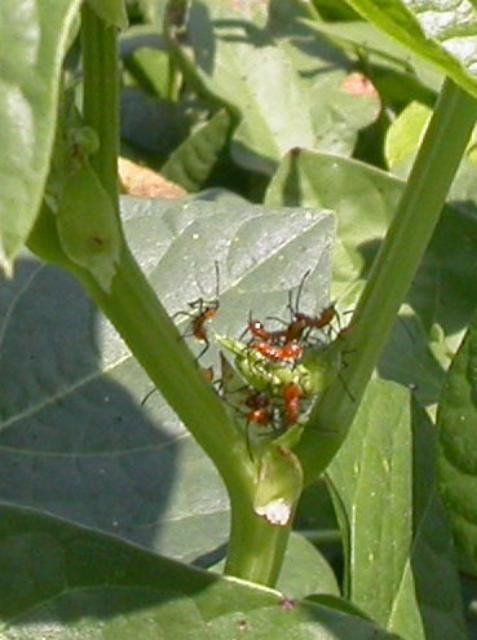
Credit: Henry Fadamiro, Auburn University
Biological Control
Adult coreids are known to be parasitized by tachinid flies, such as Trichopoda pennipes and T. plumipes. Few parasites have been recorded in eggs of L. zonatus but little research has been conducted. Reported parasitic rates on eggs of L. zonatus are as follows: Anastatus sp. (Hymenoptera: Eupelmidae), Brasema sp. (Hymenoptera: Eupelmidae), Gryon gallardoi (Hymenoptera: Scelionidae) and Trissolcus sp. (Hymenoptera: Scelionidae), 4.45, 1.8%, 45.1% and 5.3%, respectively (Xiao 2009).
In addition, ultra-low volume controlled droplet applications of entomopathogenic fungi Metarhizium anisopliae, isolate NB, at a rate of 1 x 1010 conidia/tree has shown to produce approximately 92% mortality in adults of L. zonatus. Another entomopathogenic fungi, Beauveria bassiana (Bals), isolate 119, at a dosage of 2.6 x 109 conidia/tree, produced mortality of near 99% in adults of L. zonatus (Xiao 2009).
Chemical Control
Western leaf-footed bugs are mainly managed using alternative insecticides with several products available in the market. Interestingly, in El Salvador the use of neem oil as a means of managing L. zonatus caused a peak mortality rate of up to 100 percent (Allen 1969).
Selected References
Allen RC. 1969. A revision of the genus Leptoglossus Guerin (Hemiptera: Coreidae). Entomologica Americana 45: 35-140.
Brambila J. 2007. Heteroptera of concern to Southern U.S. Colloquium of plant pests of regulatory significance, Doctor of Plant Medicine Program Seminar Series. Gainesville, Florida. Slide # 13-16.
Buss LJ, Halbert SE, Johnson SJ. (2011). Leptoglossus zonatus—A new leaf-footed bug in Florida (Hemiptera: Coreidae). Pest Alert, Florida Department of Agriculture and Consumer Service, Division of Plant Industry, Gainseville. https://www.fdacs.gov/content/download/68507/file/Pest_Alert_-_Leptoglossus_zonatus,_A_New_Leaffooted_Bug_in_Florida.pdf (July 2020).
Cordero J, Boshier D, Barrance A. 2003. Arboles de Centroamerica: un manual para extensionistas. Orton IICA/CATIE. 1079 pp.
Grimm C, Somarriba A. 1999. Suitability of physic nut (Jatropha curcas L.) as single host plant for the leaf-footed bug Leptoglossus zonatus Dallas (Het. Coreidae). Journal of Applied Entomology 123: 347-350.
Grimm C, Guharay F. 2010. Control of leaf-footed bug Leptoglossus zonatus and shield-backed bug Pachycoris klugii with entomopathogenic fungi. Biocontrol Science and Technology 8: 365-376.
Henne DC, Johnson SJ, Bourgeois WJ. 2003. Pest status of leaf-footed bugs (Heteroptera: Coreidae) on citrus in Louisiana. Proceedings of the Annual Meeting of the Florida State Horticultural Society 116: 240-241.
Marchiori CH. 2002. Natural enemies of Leptoglossus zonatus (Dallas, 1852) (Hemiptera: Coreidae) on maize in Itumbiara, Goias. Instituto Luterano de Ensino Superior de Itumbiara. (ILES). Biotemas 15: 69-74.
Panizzi RA. 2004. A possible territorial or recognition behavior of Leptoglossus zonatus (Dallas) (Heteroptera, Coreidae). Centro Nacional de Pesquisa de Soja. Revista Brasileira de Entomologia 48: 577-579.
Panizzi RA, Leal SW, Niva CC. 1994. Alarm pheromone system of leaf-footed bug Leptoglossus zonatus (Heteroptera: Coreidae). Abstract. Journal of Chemical Ecology 20: 1209.
Sbravate C, Campaner M, Camargo LEA, Conchon I, Teixeira MMG, Camargo EP. 1989. Culture and generic identification of trypanosomatids of phytophagous Hemiptera in Brazil. Journal of Protozoology 36:543-547.
Xiao Y. 2009. Biology, ecology and management of key pests of satsuma citrus in Alabama. Ph.D. Dissertation, Auburn University, Auburn, Alabama. 177 pp..
Xiao Y, Fadamiro H. 2011. Evaluation of damage to satsuma mandarin (Citrus unshiu) by the leaf-footed bug, Leptoglossus zonatus (Hemiptera: Coreidae). Journal of Applied Entomology 134: 694-703.